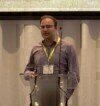Validation of fugitive methane fluxes using unmanned aerial vehicles
We present a case study of a validation experiment to characterise the precision and uncertainty constraints of a newly developed mass balancing flux calculation method, using in situ measurements of methane concentration sampled by an unmanned aerial vehicle (UAV) platform.
This case study (funded by the UK Environment Agency) was conducted by the University of Manchester and National Physical Laboratory with assistance from the UK Met Office at its Cardington research facility. The aim of the work was to validate an adapted form of the conventional mass balancing approach to flux calculation, tailored for UAV platform sampling of methane concentrations and local wind measurement. Our approach consisted of 7 UAV flights around 500 m downwind of a known methane release facility (operated by NPL), where a range of methane flux rates were released in a blind exercise. Fluxes were calculated from downwind sampling by a rotary UAV and tethered high-precision methane sensor (Los Gatos Research UGGA cavity ringdown spectrometer) and later compared with calibrated flux release data after UAV fluxes had been calculated to ensure a blind exercise (administered by the UK Environment Agency).
The results of the validation demonstrate that the method can retrieve fugitive flux to within a 10% root-mean-square bias (across 7 flights, representing ˜2 hours of sampling) with typical uncertainty of less than 40% over one flight (representing 17 minutes of UAV sampling) at ambient concentrations similar to elevations seen around UK landfills in moderate prevailing winds (< 5 m/s). Sensitivity to background and wind variability over the course of sampling were found to dominate the relative uncertainty as propagated in the mass balance flux algorithm. Future developments in UAV 3D wind measurement and onboard high-precision methane measurement may serve to reduce such error components further.
This newly validated method offers a new technology (and technique) through which industrial facility-level methane fugitive flux can be accurately and traceably quantified in case study (snapshot) approaches. Moreover, routine UAV sampling can help to monitor emissions and detect hazardous leaks quickly over a wide area, taking advantage of the portability of UAVs and their ability to safely access hazardous environments (e.g. areas of suspected strong methane leaks)
Free to watch
Sessions are free to watch. Please login to view this session or create an account.
Speakers

Dr Grant Allen (University of Manchester)
Digital Edition
PIN 25.5 Oct/Nov 2024
November 2024
Analytical Instrumentation - Picturing Viscosity – How Can a Viscometer or a Rheometer Benefit You? - Sustainable Grease Formulations: Evaluating Key Performance Parameters and Testing Method...
View all digital editions
Events
Jan 20 2025 San Diego, CA, USA
Jan 22 2025 Tokyo, Japan
Jan 25 2025 San Diego, CA, USA
SPE Hydraulic Fracturing Technology Conference and Exhibition
Feb 04 2025 The Woodlands, TX, USA
Feb 05 2025 Guangzhou, China














